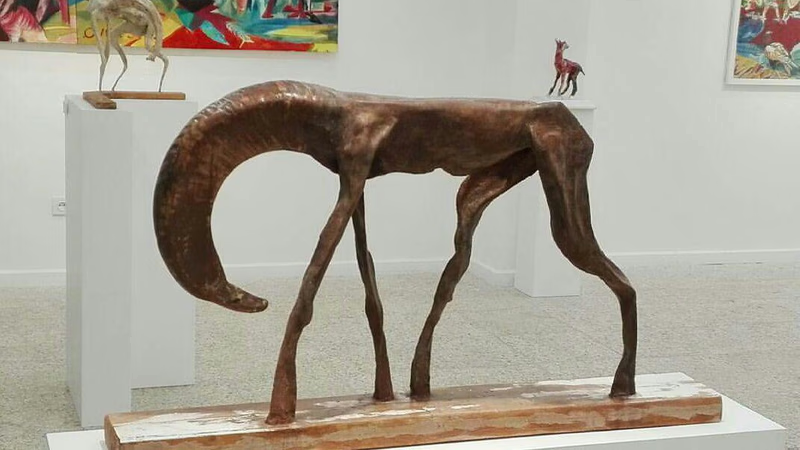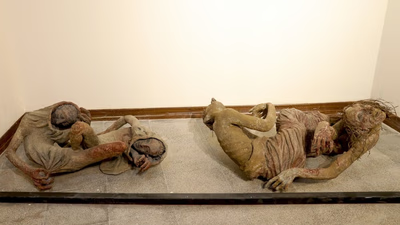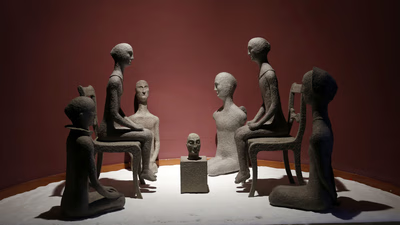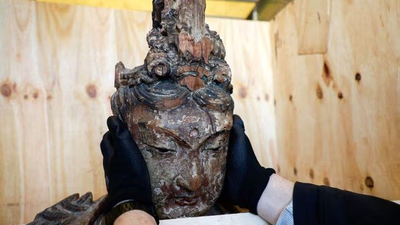
Explore unique art sculptures in the Middle East trade platform.
Buying and selling art sculptures in the modern craft market can be considered as an attractive business opportunity. Knowing the needs and demands of the market is important. Examining some examples in the market and seeing the designs, styles and prices can help in better understanding the market. It is important to find target groups of customers who are interested in art sculptures and can afford them. You can identify customers through various methods, such as market research, competition studies, and holding art-related exhibitions and events. It is important to find reliable and experienced suppliers who have the ability to make quality and unique art sculptures. You can find artists and craftspeople by visiting local galleries, studios, and art fairs.
Before buying, check the statues carefully. Examining details such as quality of construction, use of materials, base and dimensions of the statue can improve the efficiency of your purchase. Reasonable pricing is important for art sculptures. Studying similar prices in the market and negotiating with suppliers can help you determine a fair price for buying and selling statues. Creating a website or social media pages can help you reach a wider audience for your sculptures and connect with new customers. Participating in art exhibitions and events can be a good opportunity to showcase your sculptures and build relationships with local customers and businessmen. You can use local advertising methods such as advertisements in local newspapers and magazines, brochures and posters in public places, as well as television and radio advertisements.
The best way to build long-term relationships with customers is to provide superior customer service. These services include answering customers' questions and needs, providing advice on choosing statues, and after-sales support. Check out the Crafts and Sculptures Act to find out all the relevant regulations. This includes issues such as intellectual property rights, licenses and export and import restrictions. Working with those who specialize in art sculptures and marketing can help you grow your business. You can collaborate with artists, designers and marketing experts. It is suggested to adjust your strategy according to the local conditions and market needs while setting up the business and also pay attention to the new updates in the modern art sculpture industry.
Artistic sculptures are part of modern crafts and can be made of various materials such as stone, wood, metal, ceramic, glass , etc. These statues are generally made for decoration and artistic appreciation and can have different designs, sizes and artistic styles. Art sculptures can be made from different materials. Common materials include stones such as marble, wood, metal, ceramics, glass, precious and semi-precious stones, etc. Art statues can be made in different styles. Some art styles include classic, abstract, modern, expressionism, etc. Each art style has unique properties and characteristics.
Various techniques are used to make artistic sculptures. These techniques can include engraving, laser engraving, casting, sculpting, turning, welding, etc. Art statues usually have a specific concept and design. This concept and design can be inspired by various topics such as nature, human, history, religious beliefs, politics, etc. Art statues can have different dimensions. They may be very small and beautiful or large and impressive and are made according to different uses such as interior decoration, exhibitions or public works.
Art statues are important art and cultural works and are sold through exhibitions and galleries. Also, in some cases, artistic figurines are collected as works of art and displayed in museums and exhibitions. Regarding the rules and regulations for the export of artistic sculptures, as with the trade of ancient sculptures, there are different laws and regulations in each country. For the export of art sculptures, it is important to familiarize yourself with the laws and regulations of the export and protection of works of art in your country and the destination country and ensure compliance with them. In some cases, special permits may be required to export art sculptures.
-

Buying and selling art sculptures presents a lucrative opportunity in the modern craft market. Understanding market demands, customer preferences, and pricing strategies is crucial for success. Identifying target customers through market research and events can enhance sales potential. Reliable suppliers are essential; visiting local galleries and art fairs can help find quality artists. Careful examination of sculptures regarding construction quality, materials, and dimensions is vital before purchase. Competitive pricing can be achieved by studying market trends and negotiating with suppliers. Establishing an online presence through websites and social media expands reach to potential buyers. Participation in exhibitions fosters relationships with local customers and businesses.
Effective advertising methods include local media, brochures, and public displays. Superior customer service is key to building long-term relationships, addressing inquiries, and providing after-sales support. Familiarity with regulations such as intellectual property rights and export restrictions is necessary for compliance in the art trade. Collaborating with artists and marketing experts can further enhance business growth while adapting strategies to local market conditions is essential for sustainability.
-

Sculptural art in the Middle East has deep historical roots, showcasing techniques developed over thousands of years. The region"s sculptures, made from stone, wood, metal, and ceramics, are characterized by intricate details and geometric designs influenced by local literature and mythology. Notable examples include ancient stone sculptures like the Apocalypse and Assyrian statues. Contemporary Middle Eastern artists have adapted their work in response to social, political, and cultural changes, often blending traditional styles with Western influences. This evolution has led to innovative designs using various materials such as steel and aluminum. Wood sculpture remains significant, utilizing local woods for detailed carvings that reflect genealogical and animal themes. Metal sculptures emphasize decorative elements with geometric patterns. The value of these artworks is tied to the artist"s reputation and market demand. As global interest in arts grows, West Asian artists are increasingly recognized for their unique contributions to the international art scene.
-

High-quality sculptures and statues require fine details, unique designs, and the use of premium materials to enhance their artistic and commercial value. Identifying target markets is crucial for successful exporting, necessitating research into foreign artistic needs and customer preferences. Effective communication with local agents and distributors can facilitate market entry, while establishing long-term partnerships is essential for navigating trade conditions and export laws. Branding plays a significant role in marketing art; a strong brand identity can differentiate products in a competitive landscape. Marketing strategies such as advertising, public relations, and social media engagement are vital for attracting new customers. Compliance with export regulations is necessary to avoid legal issues, requiring familiarity with each country"s specific laws. Additionally, the design"s dimensions must appeal to buyers, particularly in auction settings. Providing detailed descriptions of sculptures—including materials used and artistic techniques—can enhance buyer interest.
Competing effectively in local markets involves leveraging competitive advantages like pricing, quality, and unique designs. Utilizing technology for online marketing can expand reach to new customers through professional websites and social media platforms. Collaborating with renowned artists can further boost credibility and market presence.
-

The international trade of ancient antique sculptures is a significant and profitable sector, encompassing both legal and illegal markets. Legal transactions typically occur through auctions and exhibitions, where sellers obtain necessary permits to ensure compliance with regulations. These sculptures, made from various materials, hold immense historical and cultural value, reflecting the beliefs and artistic skills of past societies. However, illegal trade poses a threat to cultural heritage, as artifacts are often smuggled and sold on black markets. The value of these antiques can be substantial, influenced by factors such as preservation state and historical significance. The rise of online platforms has transformed the marketplace for antique sculptures, allowing buyers to participate in auctions remotely. International art fairs also serve as venues for showcasing these works. Professionals in the art market play a crucial role in identifying valuable pieces and ensuring their provenance is traceable.
Legal frameworks vary by country regarding the export of antiquities, with many nations enforcing strict laws to protect their cultural heritage from theft and destruction. Compliance with these regulations is essential for preserving history while facilitating legitimate trade.




